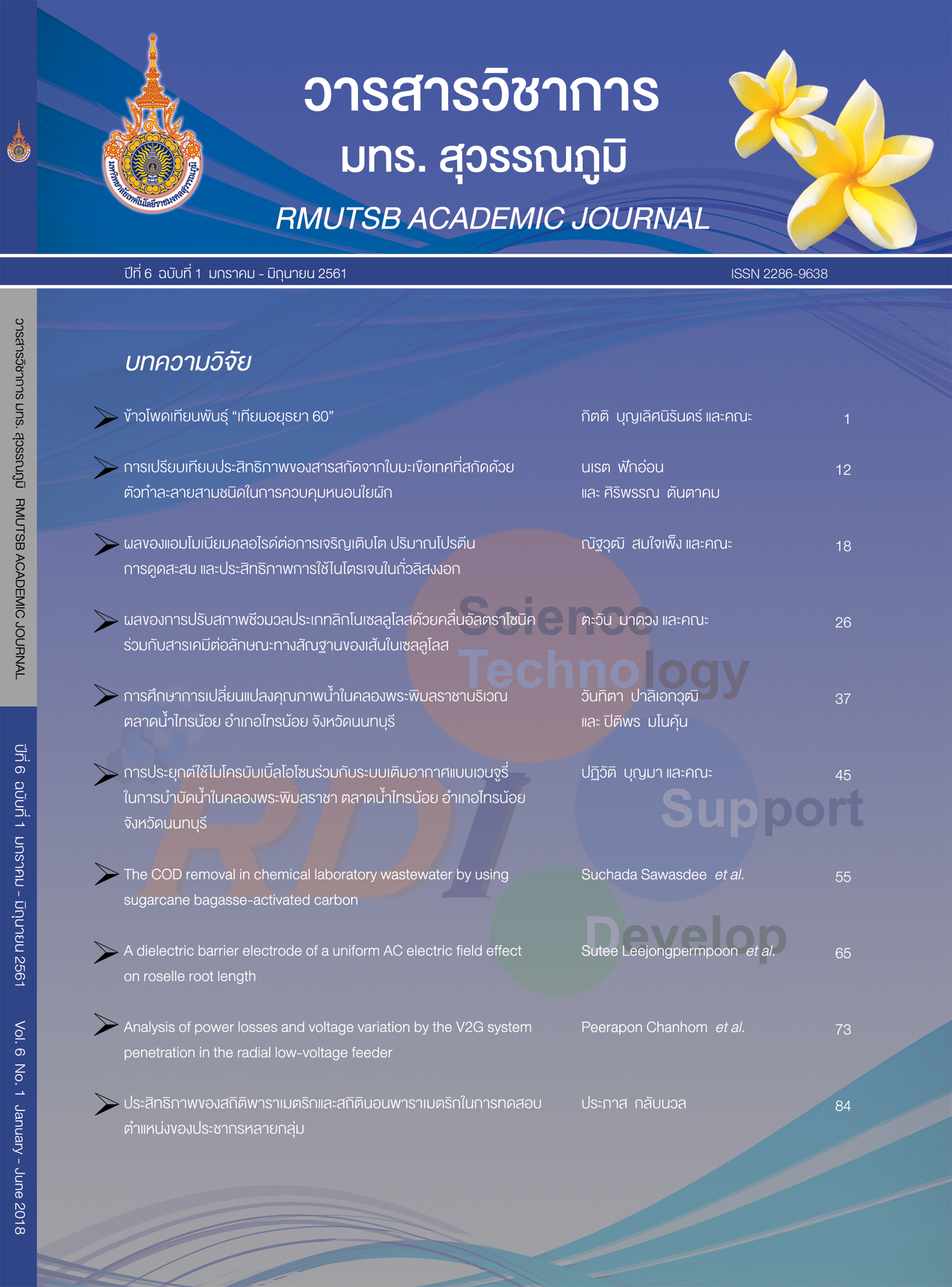The effect of using ammonium chloride on peanuts sprouts: Growth, protein content, nitrogen uptake and apparent recovery efficiency
Main Article Content
Abstract
This experiment was to study the effect of ammonium chloride (NH4Cl) on growth, protein content, nitrogen uptake and apparent recovery efficiency in peanut sprouts. The experimental design was CRD in 6 treatments and 3 replications. The result showed that the application of NH4Cl at 0.5% gave the highest fresh weight (FW) and dry weight (DW) (13.81 and 3.51 g) respectively. The application of NH4Cl at 1.0% had highest of shoot length (SL) (4.86 cm). Germination percentage (GP), it was found that the application of NH4Cl at 0 and 0.5% had the highest percent of germination (91.0%). While total nitrogen and protein content found the application of NH4Cl at 2.0% provide the highest total nitrogen and protein content (4.46 and 27.92%, respectively) In part of, nitrogen uptake and apparent recovery efficiency of nitrogen found the application of NH4Cl at 1.0 and 0.25% gave the highest of nitrogen uptake and apparent recovery efficiency of nitrogen were 13.73 mg/plant and 105.33%, respectively.
Article Details
Published manuscript are the rights of their original owners and RMUTSB Academic Journal. The manuscript content belongs to the authors' idea, it is not the opinion of the journal's committee and not the responsibility of Rajamangala University of Technology Suvarnabhumi
References
ทัศนีย์ อัตตะนันทน์ และจงรักษ์ จันทร์เจริญสุข. 2542. แบบฝึกหัดและคู่มือปฏิบัติการการวิเคราะห์ดินและพืช. ภาควิชาปฐพีวิทยา คณะเกษตรมหาวิทยาลัยเกษตรศาสตร์, กรุงเทพฯ.
ยงยุทธ โอสถสภา. 2558. ธาตุอาหารพืช. มหาวิทยาลัยเกษตรศาสตร์, กรุงเทพฯ.
สายชล สุขญาณกิจ และธนพัฒน์ ปลื้มพวก. 2558. ผลของการใช้ปุ๋ยไนโตรเจนตามค่าวิเคราะห์ดินต่อผลผลิตและธาตุอาหารหลักในข้าวเจ้าพันธุ์ กข41 ที่ปลูกในชุดดินอยุธยา. ว. วิทยาศาสตร์เกษตร (พิเศษ). 46(3): 577-580.
Akinrinde, E.A. and T. Gaizer. 2006. Differences in the performance and phosphorus-use efficiency of some tropical rice (Oryza sativa L.) varieties. Pak. J. Nutri. 5 (3): 206-211.
AOAC. 1990. Official method of analysis. 15th ed. Association of official analytical chemistry Inc., Virginia.
Biljana, B., G. Delic, M. Topuzovic and M. Stankovic. 2010. Effect of NaCl on seed germination in some species from families of Brassicaceae and Solanaceae. Kragujevac J. Sci. 32: 83-87.
ISTA (International Seed Testing Association). 2013. International rules for seed testing: rule 2013. International Seed Testing Association. Zurich, Switzerland.
Kabata-Pendias, A. and H. Pendias. 1992. Trace elements in soils and plants. 2nd ed. CRC Press, Boca Ratón, Florida.
Openshaw, M.D. 1970. The effect of ammonia on germination and development of seedlings in soil. Ph.D. Dissertation. Iowa State University, Michigan.
Panich-pat, T. and P. Srinives. 2009. Partitioning of lead accumulation in rice plant. Thai. J. Agric. Sci. 42(1): 35-40.
Sui, B., X. Feng, G. Tian, X. Hu, Q. Shen and S. Guo. 2013. Optimizing nitrogen supply increases rice yield and nitrogen useefficiency by regulating yield formation factors. Field Crop Res. 150: 99-107.
Tayefe, M., A. Gerayzade, E. Amiri and A.N. Zade. 2011. Effect of nitrogen fertilizer on nitrogen uptake, nitrogen use efficiency of rice. pp. 470-473. In: International Conference on Biology, Environment and Chemistry, 28-30 December 2011. IACSIT Press, Singapore.
Thomason, W.E., K.J. Wynn, K.W. Freemnan, E.V. Lukina, R.W. Mullen, G.V. Johnson, R.L. Waterman and W.R. Raun. 2001. Effect of chloride fertilizer and lime on wheat grain yield and take-all disease. J. Plant Nutri. 24(4&5): 683-692.


